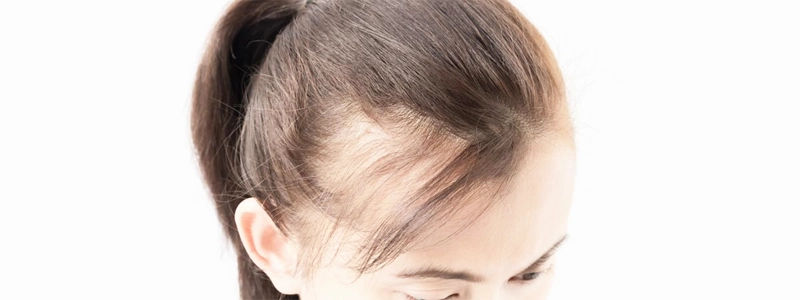It’s normal to lose between 50- 100 hairs a day. You may experience losing more hair than is normal if you notice a large amount of hair in the drain after washing your hair or clumps of hair in your brush.
If you notice that you are losing more hair than usual, you should discuss the problem with doctor or pharmacist. They can suggest appropriate treatment plan.
What causes hair loss?
- Hormonal Changes
- Pregnancy
- Childbirth
- Menopause
- Medical Conditions
- Thyroid disease
- Scalp infections like ringworm
- Medication used to treat cancer
- Stress
- Family history (heredity)
- Nutrition Deficiency
- Effect of certain hair styles (wearing tight ponytail and braids)
In men, the typical pattern of hair loss is a receding hair line with loss of hair from the top and front of the head, often in a classic M-shaped pattern. In women, the usual pattern of hair loss is thinning at the crown of the head, with the frontal hairline over the forehead remaining.
Androgenetic Alopecia is caused by both genetic and hormonal factors. This form of hair loss is related to hormones called androgens, particularly an androgen called dihydrotestosterone (DHT). Increased levels of androgens such as DHT in hair follicles can lead to a shorter cycle of hair growth and the growth of shorter and thinner strands of hair. Follicles can also stay in the resting phase for longer periods of time.
Traction Alopecia is a type of hair loss caused by constant pulling. The commonest cause is tight hairstyles such as braids or a ponytail. It can also occur from using chemical relaxers or even hair extensions. Traction Alopecia is not usually permanent, especially if it is diagnosed early. Often, recognizing the problem and avoiding putting strain on the hair will allow full regrowth. If Traction Alopecia is diagnosed too late, the hair follicles may have been destroyed and hair will not regrow.
Management of Hair Loss
MEDICATION
- Finasteride (Propecia) is used in male-pattern hair loss in a pill form, taken 1 milligram per day. It is not indicated for women and pregnant women.
- Minoxidil (Rogaine or Regro) is available OTC and applied twice daily to the scalp, eyebrows, and beard.
- Dutasteride is another oral medication that works similarly to finasteride.
MULTIVITAMIN FOR HAIR LOSS
- Vitamins A, B, E
All are important to the hair growth and retention processes. - Biotin
Studies suggest that including biotin-rich food in your diet or taking biotin supplement may slow hair loss such as nuts, sweet potatoes, eggs, onions and oats in your diet. - Iron, Folic Acid, Zinc
Healthy hair needs these to keep growing thick and strong.
HAIR CARE
- Anti-thinning shampoo
Shampoo for hair loss contain vitamins and amino acids that provide healthier scalp to generate more hair over time. You can also ask your doctor/pharmacist about the right selection of shampoo. - Scalp massage
When you wash your hair, gently apply pressure with your fingertips (not finger nails) around your scalp to increase blood flow, resulting in hair re-growth. - Gentle styling
Skip tight braids or ponytails that may pull on hair at the root and lead to hair loss. Must always dry your hair before styling to avoid irritating scalp. - Avoid constant heating and drying
Heat weakens hair proteins, and constant heating and drying can lead to weakness and fragility that causes hair loss. - Keep away from chemicals
Harsh chemicals and permanent hair colour products could be damaging for hair health.
NATURAL REMEDIES
- Onion juice
Onion juice helps in blood circulation and promoting hair growth. Apply the juice to your scalp and hair and leave in for at least 15 minutes or leave it overnight and wash it normally. Do it regularly for a week and you will see noticeable result. - Coconut oil
Coconut oil contains fatty acids that penetrate inside the hair shaft and reduce protein loss from hair. Coconut oil can be used either before or after you wash your hair depending on your hair type. If your hair tends to be oily, you can do a leave-in treatment overnight or for a few hours before you wash it. Massage it into your scalp and all of your hair. If your hair is dry, you can also use it as a leave-in treatment.
If you want to improve your hair, come up with a plan and stay consistent. Remember that the treatments may take a few months to yield noticeable results.
It’s important that you take time each day to focus on nourishing your hair to get the luscious locks you want. Taking this step and practicing self-care will be extra beneficial if your hair loss is related to any emotional or stress-related issue.
Stay positive and do your best to maintain a healthy lifestyle that will complement your hair treatment plan.















